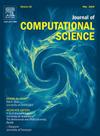Cutting voxel projector a new approach to construct 3D cone beam CT operator
IF 3.7
3区 计算机科学
Q2 COMPUTER SCIENCE, INTERDISCIPLINARY APPLICATIONS
引用次数: 0
Abstract
We introduce a novel class of projectors for 3D cone beam tomographic reconstruction. Analytical formulas are derived to compute the relationship between the volume of a voxel projected onto a detector pixel and its contribution to the line integral of attenuation recorded by that pixel. Based on these formulas, we construct a near-exact projector and backprojector, particularly suited for algebraic reconstruction techniques and hierarchical reconstruction approaches with nonuniform voxel grids. Unlike traditional projectors, which assume a uniform grid with fixed voxel sizes, our method enables local refinement of voxels, allowing for adaptive grid resolution and improved reconstruction quality in regions of interest. We have implemented this cutting voxel projector along with a relaxed, speed-optimized version and compared them to two established projectors: a ray-tracing projector based on Siddon’s algorithm and a TT footprint projector. Our results demonstrate that the cutting voxel projector achieves higher accuracy than the TT projector, especially for large cone beam angles. Furthermore, the relaxed version of the cutting voxel projector offers a significant speed advantage, while maintaining comparable accuracy. In contrast, Siddon’s algorithm, tuned to achieve the same accuracy, is considerably slower than the cutting voxel projector. All algorithms are implemented in a GPU optimized open-source framework for algebraic reconstruction.

切割体素投影仪是构建三维锥束CT算子的一种新方法
介绍了一种用于三维锥束层析成像的新型投影仪。导出了解析公式来计算投影到检测器像素上的体素的体积与其对该像素记录的衰减线积分的贡献之间的关系。基于这些公式,我们构建了一个接近精确的投影仪和反向投影仪,特别适合于代数重建技术和具有非均匀体素网格的分层重建方法。与传统投影仪不同,传统投影仪假设具有固定体素大小的均匀网格,我们的方法可以对体素进行局部细化,从而允许自适应网格分辨率并提高感兴趣区域的重建质量。我们已经实现了这个切割体素投影仪以及一个轻松的,速度优化的版本,并将它们与两个既定的投影仪进行比较:一个基于Siddon算法的光线追踪投影仪和一个TT足迹投影仪。我们的研究结果表明,切割体素投影仪比TT投影仪具有更高的精度,特别是对于大锥光束角度。此外,轻松版的切割体素投影仪提供了显著的速度优势,同时保持相当的精度。相比之下,西登的算法,调整到达到同样的精度,比切割体素投影仪慢得多。所有算法都在GPU优化的代数重构开源框架中实现。
本文章由计算机程序翻译,如有差异,请以英文原文为准。
求助全文
约1分钟内获得全文
求助全文
来源期刊

Journal of Computational Science
COMPUTER SCIENCE, INTERDISCIPLINARY APPLICATIONS-COMPUTER SCIENCE, THEORY & METHODS
CiteScore
5.50
自引率
3.00%
发文量
227
审稿时长
41 days
期刊介绍:
Computational Science is a rapidly growing multi- and interdisciplinary field that uses advanced computing and data analysis to understand and solve complex problems. It has reached a level of predictive capability that now firmly complements the traditional pillars of experimentation and theory.
The recent advances in experimental techniques such as detectors, on-line sensor networks and high-resolution imaging techniques, have opened up new windows into physical and biological processes at many levels of detail. The resulting data explosion allows for detailed data driven modeling and simulation.
This new discipline in science combines computational thinking, modern computational methods, devices and collateral technologies to address problems far beyond the scope of traditional numerical methods.
Computational science typically unifies three distinct elements:
• Modeling, Algorithms and Simulations (e.g. numerical and non-numerical, discrete and continuous);
• Software developed to solve science (e.g., biological, physical, and social), engineering, medicine, and humanities problems;
• Computer and information science that develops and optimizes the advanced system hardware, software, networking, and data management components (e.g. problem solving environments).
 求助内容:
求助内容: 应助结果提醒方式:
应助结果提醒方式:


